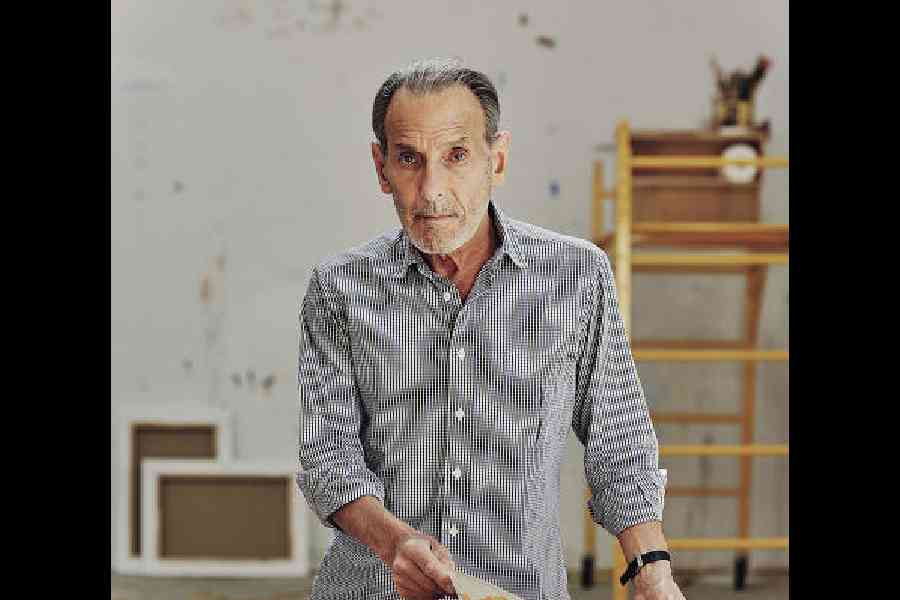The Apprentice


Of the many young artists David Salle (in pic) has mentored, none were as challenging as his latest student, who cannot hold a paintbrush or a conversation.
“The mountain looks too airbrushed,” Salle informed the algorithm that lives inside his iPad. The landscape painting it had produced, based on hundreds of his own artworks, was typically generic, lacking in depth. But the next one succeeded, depicting a valley stream with expressionistic wisps and a sense of volume.
“The way it has rendered water looks more deliberate,” Salle, 70, said. “But it’s funny to call something deliberate when it has no consciousness, isn’t it?”
For nearly a year, the painter — known for edgy images appropriated from art history and popular culture, as well as juxtapositions of voluptuous nudes and ham sandwiches — has attempted to defy conventional thinking about generative artificial intelligence by testing an AI program’s capacity to become a sophisticated creator of art.
The partnership has grown through weekly meetings with two technologists, Danika Laszuk and Grant Davis, who tailored a text-to-image model to Salle’s requirements, relying on descriptive prompts that generated images in the artist’s style. The New York Times observed three of their work sessions, tracking the algorithm’s progress over several months as it adopted more of Salle’s techniques and abandoned the bland photorealism that often limits other generative programs.
We are sending the machine to art school,” Salle quipped. The algorithm wouldn’t need eyes to achieve greatness, but it would need to hone the robotic equivalent of intuition to spark inspiration and fool a gallerist.

And first, it would have to learn to mimic his style.
The experiment was a mutually beneficial arrangement. Laszuk runs a programme, called E.A.T__WORKS, for the venture capital firm Betaworks. It pairs artists and engineers on projects where her company might earn a percentage of the profits. Davis is building Wand, an AI platform for artists that promises to help them streamline their operations with faster imaging through text prompts and sketching. Salle was like a guinea pig for Wand, teaching its program how to paint while developing his own series of digital images.
With permission from Ben Lerner, a friend of Salle’s, the group has been feeding bits of poetry from his new book, The Lights, to evoke more fantastical images of cities growing within organic cells, and patterns of interlocking barbules. Prompts also have been sourced from another friend, writer Sarah French.
“Our process starts with very imaginative prompts,” Davis said. “And we generate lots of images before selecting the ones we like. Then David starts drawing on top of them. The process can keep repeating itself like that until he’s satisfied.”
Salle is one of the first traditional artists to embed on the front lines of AI. He, in turn, was trained by conceptualist John Baldessari at the California Institute of the Arts in the US in the 1970s and has a style that absorbs a diverse set of influences, from Italian painter Giorgio de Chirico to New Yorker cartoonist Peter Arno.
Artificial intelligence has a limitless vault of forms, thanks to the billions of online images it studies through a process called diffusion, in which the algorithm learns the structure of an image — and then learns to create variations. Its knowledge is then stored in the parameters of the model, which is translated to the AI through a short sequence of numbers known as “latent space”.
But learning artistic style requires going beyond simple pattern recognition. Experts say that increased matchmaking improves accuracy but also stymies the machine’s ability to produce the unexpected. A balance must be struck.
The algorithm’s “training” to become the next David Salle started with a diffusion model to develop a general understanding of visual images based on hundreds of the artist’s paintings. Davis, the engineer, then introduced dozens of detailed snapshots of Salle’s paintings to the program so it would learn to “think like a painter”.
Some of the first experiments were underwhelming: blobby landscapes, figures drawn without brushstrokes, flat abstraction. But the critiques that Salle offered did improve the machine’s intelligence enough to surprise the artist.
What will become of his own identity, as the algorithm continues to produce more Salle paintings than he could ever imagine? Some days, it seems like the algorithm is an assistant. Other days, it’s like a child. When asked if the AI would replace him entirely one day, the artist merely shrugged. “Well,” he said, “that’s the future.”
NYTNS